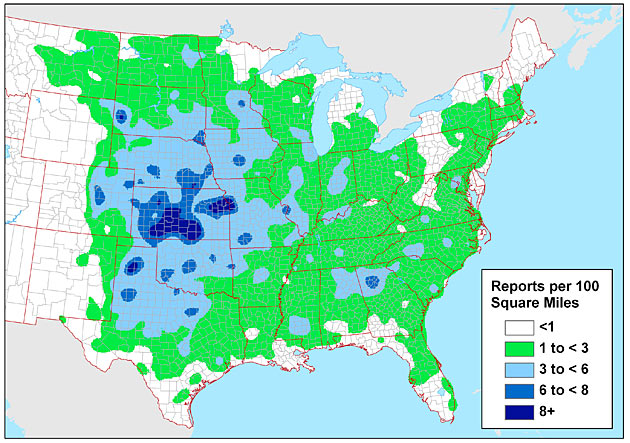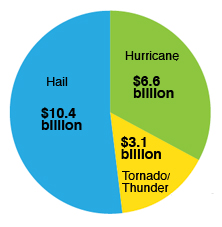 U.S. HAIL ACTIVITY 2000-2009 - The average number of storms U.S. counties have reported per year with hail stones one inch in diameter or larger. (Graphic courtesy of Insurance Institute for Business & Home Safety)[/caption]
U.S. HAIL ACTIVITY 2000-2009 - The average number of storms U.S. counties have reported per year with hail stones one inch in diameter or larger. (Graphic courtesy of Insurance Institute for Business & Home Safety)[/caption]Hail is viewed as a weather oddity. Unless the falling balls of ice are abnormally large, they probably won’t make the news. “This doesn’t always get a lot of attention in the media because there aren’t a lot of injuries and deaths associated with hail storms,” said Tanya Brown, Ph.D., research engineer at the Insurance Institute for Business & Home Safety (IBHS). “But there is a tremendous amount of property damage done each year.”
Few states know this as well as Texas. Overall, weather has caused more than half the insured losses paid out by property and casualty insurers in the Lone Star State since 1999. Hurricanes, tornadoes, thunderstorms and hail have been the primary culprits, but despite the lack of attention paid to it, hail has been the biggest driver of losses. In fact, by causing more than $10 billion in insured losses from 1999 to 2011, hail has cost Texas more than hurricanes and tornadoes combined.
To raise awareness of the threat, the Texas Department of Insurance hosted a “War on Hail” conference last November. Some 300 stakeholders — including lawmakers, regulators, insurers, policyholders, weather forecasters, roofers, engineers and damage experts — gathered to discuss ways to combat this oft-overlooked peril.
Brown was there to discuss impact-resistant roofing materials, which can help businesses withstand damage. Among the options are metal, asphalt shingles and roof-covering sheets made of durable materials (wood, metal, slate) that are designed to look like decorative tiles. But as Jenny Pye of Liberty Mutual Insurance pointed out at the symposium, “impact-resistant” does not mean “hail proof.”
The largest hail stone verified by the National Weather Service, for instance, fell in South Dakota in 2010 and measured eight inches in diameter — the size of a volleyball. Hail that size is obviously atypical, but large stones that exceed the current maximum diameter that products are tested against do drop regularly. “We do see products withstand higher impacts, but there are no test standards above two inches,” said Brown.
[caption id="attachment_12547" align="alignright" width="222"]
 THE COST OF HAIL IN TEXAS
THE COST OF HAIL IN TEXASFrom 1999-2011, hail cost Texas property/casualty insurers more than hurricanes, tornadoes and thunderstorms combined.[/caption]
She points to a 2011 storm in Dallas with reported hail stones as big as four inches across. “At that point, almost everything is going to be damaged,” said Brown.
IBHS is one of the major test facilities that determines how well building materials can withstand the onslaught. The institute’s researchers launch hail stones of various sizes at buildings with different roof materials to see when the effects begin to show and whether it is just cosmetic damage or functional damage.
The former is the equivalent of getting into a fender bender in the parking lot: you plan to fix the dent in the bumper, but the only real damage it is ever going to do is to your vanity. Functional damage, however, is much more insidious, as it often allows water to seep inside the building’s envelope and destroy property within.
Sometimes hail storms can even blur the line between the two. Damage that may appear to be just cosmetic can degrade the building materials to the point that their lifespan becomes shorter. “Just because it’s not leaking right now doesn’t mean it won’t be leaking a year from now,” said Brown. “Whereas if it was undamaged, it would have lasted five, 10, 15 more years.”
That is when water can creep in — into the insulation, the ceilings, the wall systems — and turn what seemed like just a few dents in the roof into a significant loss event.
“If you’re a business owner, that becomes really problematic because you may have to shut down and have business interruption costs as well,” said Brown. “So anything you can do to prevent the progressive chain of failures is always a good idea.”
As always, cost is a factor. But Brown suggests that, for companies in hail-prone areas like Texas, making the investment is likely worth the extra expense. “Look at your risk,” said Brown. “If you’re in a place that sees a couple hail storms a year, it may be worth taking that cost to put in hail-resistant products.”
